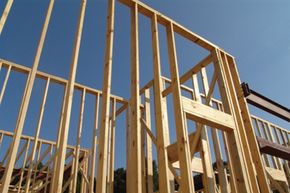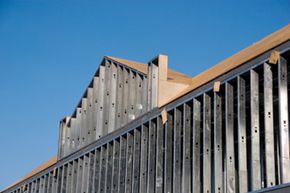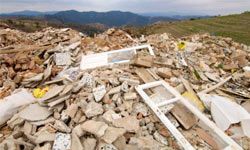Most houses are built with wooden studs. Mine, constructed in the 1970s, is no exception. It's what we're all used to (unless you happen to be a commercial contractor). If you've seen a house being built, studs are the long (typically several feet long) vertical pieces of lumber, usually measuring 2 inches by 4 inches (5 centimeters by 10 centimeters) or 4 inches by 6 inches (10 centimeters by 15 centimeters) that form the framework.
Houses are generally constructed using a method called stick frame, with the studs being the sticks and rectangular platforms -- like subfloors and ceiling joists -- being the frames. The studs bear the load of the interior and exterior walls, as well as the roof. But it's just one way to build in what's called light frame building. Wooden studs are typically used in houses and small apartment buildings, but they're just one way to frame a house.
Advertisement
Steel studs have long been employed in commercial construction for a bunch of different reasons, and lately, they're becoming more popular in residential buildings, too. With wooden studs, you have to worry about problems like rotting, warping, shrinking, cracking and splitting. Termites, other insects and mold can also quickly destroy wooden studs under the right conditions. Finding quality lumber to use as studs can also be difficult; it varies widely depending on where the wood is grown. Lumber also has to be sorted carefully and you can't use any pieces that aren't straight or have knots, cracks or other imperfections. As much as 20 percent of the lumber bought for studs ends up wasted, and since wood prices can fluctuate, trying to budget for a construction project is challenging.
You can cast those concerns aside with steel studs. Not only are they impervious to everything that affects an organic material like wood, they also won't burn in a fire. These lighter and more stable studs can also withstand earthquakes and tornadoes better than their wooden counterparts, potentially snagging you lower homeowner's insurance premiums. Part of the reason is because steel studs call for screws instead of nails, which is a more stable connection. If you make a mistake in spacing or measuring, you can always unscrew the studs. It's not as easy with wooden studs that are cut and nailed together.
There are no variations to worry about, because the steel industry sets forth standards that all studs must meet. That also means very little waste -- about 2 percent instead of 20. The scrap is totally recyclable, and the cost of steel doesn't fluctuate as much as that of wood. Initially, you may pay more when you buy steel studs, but since they're impervious to just about everything but rust, you can save money over time.
So if steel studs are so fantastic, why aren't wooden ones obsolete? Read on to find out about some of the challenges.
Advertisement



